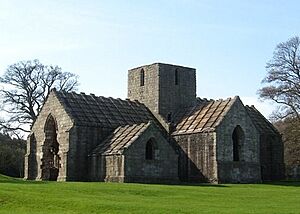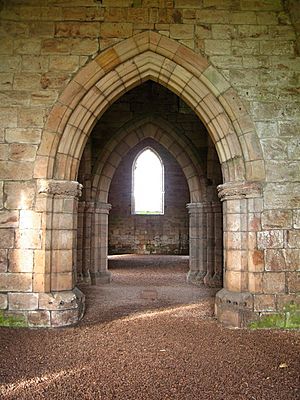Dunglass Collegiate Church facts for kids
Dunglass Collegiate Church is a very old church located in south-east East Lothian, Scotland. It's about one mile north of Cockburnspath, near the old A1 road. This special building is protected as a scheduled monument, which means it's an important historical site.
Contents
History of the Church
How Dunglass Church Began
We don't know the exact year the chapel, dedicated to St. Mary of Dunglass, was built. But we know it was already there in 1421. That's when Sir Alexander Home was given the lands of Dunglass. The chapel was right next to Dunglass Castle, which isn't there anymore.
In 1423, Sir Alexander Home decided to make the chapel even more important. He hired priests to pray for his family. This changed the chapel into a collegiate church. This means it had a "college" of priests, not just one. King James II of Scotland agreed to this in 1450. Even Pope Nicholas V confirmed it. The college included a leader called a provost, three chaplains, and four boy singers.
In November 1500, George Home of Ayton also helped the church. He paid for a chaplain to sing at the altar of "Our Lady of Pity." The church first had a main hall (nave) and a choir area. It also had a special burial place for the Home family. Later, in the 1500s, new parts called transepts were added. A new tower was built too.
Challenges and Changes
In 1544, the church and castle faced an attack. This happened during a time of wars called the Rough Wooing. An army led by the Earl of Hertford tried to take over. But the local people fought back and stopped them.
In 1560, the church closed its doors. This was because of the Scottish Reformation. This big change meant Scotland moved away from the Roman Catholic Church. In 1563, a Scottish law made Catholic mass illegal forever. So, Dunglass Church stopped being a Roman Catholic chapel.
Near the church, there was also a hospital in its early days. It was built to help sick people. This hospital was dedicated to St. Mary and John the Baptist. The church building itself is made of smooth sandstone blocks. Its roof is made of stone slabs, but the tower no longer has a roof.
Later Years of the Church
From Parish Church to Barn
After the Reformation, Dunglass Church was still used. It served as a local parish church until the 1700s. Then, it was sold to a farmer. Sadly, the church was not treated with respect for a while. The farmer even knocked down the east window. He did this to make space for his vehicles. The church, including the family burial area, was used as a barn.
The widow of Alexander Home, 1st Earl of Home, who died in 1619, wanted to build a marble tomb for her husband. She talked to a sculptor named Nicholas Stone. But nothing was ever built. She died in London in 1644. Her body was brought to Dunglass to be buried there.
Restoration and New Owners
In 1807, the church started to get some of its dignity back. Sir John Hall bought the Dunglass estate. His family later used the south transept as their own burial place. In 1919, the Usher family bought the estate.
Dunglass Church Today
Today, Dunglass Church is looked after by Historic Environment Scotland. It is in a beautiful spot. The church is surrounded by neat lawns and thick woods. There's also an interesting sundial on a small hill nearby. Dunglass Collegiate Church is considered one of the best places to visit in East Lothian.
See also



